Evaluation of Measurement Procedures for Solid Particle Number (SPN) Measurements during the Periodic Technical Inspection (PTI) of Vehicles
Abstract
1. Introduction
2. Materials and Methods
2.1. Vehicles
2.2. Instrumentation
2.2.1. Reference Instruments
2.2.2. SPN-PTI (PTI23) Sensors
2.2.3. Opacity Meter
2.3. Experimental Setup and Procedures
2.3.1. PTI23 Sensors and Opacity Assessment
2.3.2. Testing Protocols Comparison and Repeatability
2.3.3. Testing Protocol after a DPF Regeneration
2.3.4. Type Approval Tests
3. Results
3.1. Cold vs. Hot Idling Concentrations
3.2. Procedure and Repeatability
3.3. Idling Emissions after a DPF Regeneration
3.4. Correlation of Type Approval with SPN-PTI Tests
3.5. SPN-PTI vs. Opacity
4. Conclusions
- Opacity tests did not identify malfunctioning DPF in contrast to the SPN-PTI method, which is much more sensitive and can be applied to modern diesel vehicles equipped with high efficiency particulate filters.
- At cold low idling, the sub-23 nm particles concentration (up to 1600% of >23 nm levels) was much higher than at normal diesel vehicle trips and this is a source of high uncertainty due to the deviation of SPN-PTI sensors compared to reference systems. Testing with a hot engine significantly reduces the sub-23 nm concentrations (<700% of >23 nm levels), as well as the uncertainty.
- Volatile particles at low idling were high (370% of >10 nm levels) when DOC was bypassed, but they did not depend on the engine temperature. Most importantly, according to our results, they did not influence the accuracy of the SPN-PTI sensors.
- For a vehicle with hot low idling emissions in the 105 #/cm3 range, the examination of different measurement protocols and the emission levels over five different days showed that the duration of the SPN-PTI tests (5 s or 15 s or 30 s, one or three repetitions) did not contribute significantly to the uncertainty of the method when EGR status remained stable. The variability of the emissions measured with different protocols was <15%. Opening of the EGR could impact around 30% the emissions. Thus, short tests are proposed as they can precisely determine the low idling SPN concentration. Instead, the DPF fill state at different testing days was the main factor that influenced results’ repeatability. The differences of hot low idling concentrations at five different days were 50–60%.
- Testing vehicles that comply with type approval requirements right after a DPF regeneration resulted in very high SPN23 emissions exceeding the DE limit of 2.5 × 105 #/cm3. According to our results, a conditioning with free accelerations for a minimum period of 300 s could reduce the SPN23 emissions to levels that are more comparable with normal DPF trapping efficiency (<5 × 104 #/cm3).
- Comparison between type approval and hot low idle tests confirmed previous studies that reported good correlation between the two measurements. The correlation factor, in close agreement with previous studies, was determined to be 8.2 × 106 cm3/km, meaning that a vehicle that fails to pass type approval tests emits at low idling >7 × 104 #/cm3. Considering the uncertainty of the correlation, low idling emission levels of <105 #/cm3 mean that a vehicle is fulfilling the type approval limit.
- Our experimental data showed that the maximum SPN-PTI instruments deviation to reference instruments used for type-approval tests for SPN23 concentrations >2.5 × 104 #/cm3 was ~100%. Thus, considering that >105 #/cm3 low idling emission levels correspond to SPN levels exceeding the type approval limit, our data suggest that the limit ≥2.5 × 105 #/cm3 is in good agreement with the uncertainty of the procedure and the instrumentation.
Author Contributions
Funding
Institutional Review Board Statement
Informed Consent Statement
Data Availability Statement
Acknowledgments
Conflicts of Interest
Disclaimer
References
- Ramanathan, V.; Crutzen, P.J.; Kiehl, J.T.; Rosenfeld, D. Aerosols, Climate, and the Hydrological Cycle. Science 2001, 295, 2119–2124. [Google Scholar] [CrossRef]
- Pope, C.A., III; Dockery, D.W. Health Effects of Fine Particulate Air Pollution: Lines That Connect. J. Air Waste Manag. Assoc. 2006, 56, 709–742. [Google Scholar] [CrossRef]
- Brook, R.D.; Rajagopalan, S.; Pope, C.A., III; Brook, J.R.; Bhatnagar, A.; Diez-Roux, A.V.; Holguin, F.; Hong, Y.; Luepker, R.V.; Mittleman, M.A.; et al. Particulate Matter Air Pollution and Cardiovascular Disease: An Update to the Scientific Statement from the American Heart Association. Circulation 2010, 121, 2331–2378. [Google Scholar] [CrossRef]
- European Environmental Agency Air Quality in Europe: 2021 Report. Available online: https://www.eea.europa.eu/publications/air-quality-in-europe-2021/air-quality-status-briefing-2021 (accessed on 20 June 2022).
- Shaddick, G.; Thomas, M.L.; Ruggeri, G.; Gumy, S. Half of the World’s Population Are Exposed to Increasing Air Pollution. NPJ Clim. Atmos. Sci. 2020, 3, 23. [Google Scholar] [CrossRef]
- Belis, C.A.; Karagulian, F.; Larsen, B.R.; Hopke, P.K. Critical Review and Meta-Analysis of Ambient Particulate Matter Source Apportionment Using Receptor Models in Europe. Atmos. Environ. 2013, 69, 94–108. [Google Scholar] [CrossRef]
- Giechaskiel, B.; Melas, A.; Martini, G.; Dilara, P. Overview of Vehicle Exhaust Particle Number Regulations. Processes 2021, 9, 2216. [Google Scholar] [CrossRef]
- Huertas, J.I.; Mogro, A.E.; Mendoza, A.; Huertas, M.E.; Ibarra, R. Assessment of the Reduction in Vehicles Emissions by Implementing Inspection and Maintenace Programs. Int. J. Environ. Res. Public Health 2020, 17, 4730. [Google Scholar] [CrossRef]
- Pilat, M.J.; Ensor, D.S. Plume Opacity and Particulate Mass Concentration. Atmos. Environ. 1970, 4, 163–173. [Google Scholar] [CrossRef]
- Hessami, M.A.; Child, C. Statistical Analysis of Diesel Vehicle Exhaust Emission: Development of Empirical Equations to Calculate Particulate Emission; Technical Paper no. 2004-01-3066; SAE International: Warrendale, PA, USA, 2004. [Google Scholar] [CrossRef]
- Mayer, A.; Matter, U.; Scheidegger, G.; Czerwinski, J.; Wyser, M.; Kieser, D.; Weidhofer, J. Particulate Traps for Retro-Fitting Construction Site Engines VERT: Final Measurement and Implementation. SAE Tech. Pap. 1999, 108, 90092. [Google Scholar] [CrossRef]
- Jones, M. Advanced Opacitymeters: Their Potential Role in Future Emission Testing Legislation for Diesel Vehicles. In Proceedings of the 6th ETH Conference on Nanoparticle Measurement, Zurich, Switzerland, 19–21 August 2002. [Google Scholar]
- Giechaskiel, B.; Maricq, M.; Ntziachristos, L.; Dardiotis, C.; Wang, X.; Axmann, H.; Bergmann, A.; Schindler, W. Review of Motor Vehicle Particulate Emissions Sampling and Measurement: From Smoke and Filter Mass to Particle Number. J. Aerosol. Sci. 2014, 67, 719–749. [Google Scholar] [CrossRef]
- Yamada, H. Improving Methodology of Particulate Measurement in Periodic Technical Inspection with High-Sensitivity Techniques: Laser Light Scattering Photometry and Particle Number Method. Emiss. Control Sci. Technol. 2019, 5, 37–44. [Google Scholar] [CrossRef]
- Boveroux, F.; Cassiers, S.; Buekenhoudt, P.; Chavatte, L.; De Meyer, P.; Jeanmart, H.; Verhelst, S.; Contino, F. Feasibility Study of a New Test Procedure to Identify High Emitters of Particulate Matter during Periodical Technical Inspection; Technical Paper no. 2019-01-1190; SAE International: Warrendale, PA, USA, 2019. [Google Scholar] [CrossRef]
- Kadijk, G.; Elstgeest, M.; Ligterink, N.E.; Van der Mark, P.J. Investigation into a Periodic Technical Inspection (PTI) Test Method to Check for Presence and Proper Functioning of Diesel Particulate Filters in Light-Duty Diesel Vehicles—Part 2. TNO Rep. 2017, TNO 2017 R10530. [Google Scholar]
- Giechaskiel, B.; Lähde, T.; Suarez-Bertoa, R.; Valverdre, V.; Clairotte, M. Comparisons of Laboratory and On-Road Type-Approval Cycles with Idling Emissions. Implications for Periodical Technical Inspection (PTI) Sensors. Sensors 2020, 20, 5790. [Google Scholar] [CrossRef]
- Technical Instruction, TA-024/21; VERT Association PTI by Particle Count PN at Low Idle. VERT Recommended Procedures and Instruments. VERT: Niederweningen, Switzerland, 2021.
- Burtscher, H.; Lutz, T.; Mayer, A. A New Periodic Technical Inspection for Particle Emissions of Vehicles. Emiss. Control Sci. Technol. 2019, 5, 279–287. [Google Scholar] [CrossRef]
- Melas, A.; Selleri, T.; Suarez-Bertoa, R.; Giechaskiel, B. Evaluation of Solid Particle Number Sensors for Periodic Technical Inspection of Passenger Cars. Sensors 2021, 21, 8325. [Google Scholar] [CrossRef]
- Jarosinski, W.; Wisniowski, P. Verifying the Efficiency of a Diesel Particulate Filter Using Particle Counters with Two Different Measurements in Periodic Technical Inspection of Vehicles. Energies 2021, 14, 5128. [Google Scholar] [CrossRef]
- Bainschab, M.; Schriefl, M.A.; Bergmann, A. Particle Number Measurements within Periodic Technical Inspections: A First Quantitative Assessment of the Influence of Size Distributions and the Fleet Emission Reduction. Atmos. Environ. X 2020, 8, 100095. [Google Scholar] [CrossRef]
- Fleischman, R.; Amiel, R.; Czerwinski, J.; Mayer, A.; Tartakovsky, L. Buses Retrofitting with Diesel Particle Filters: Real-World Fuel Economy and Roadworthiness Test Considerations. J. Environ. Sci. 2018, 67, 273–286. [Google Scholar] [CrossRef]
- Li, J.; Ge, Y.; Wang, H.; Yu, C.; Yan, X.; Hao, L.; Tan, J. Effects of Different Diesel Particulate Filter on Emission Characteristics of In-Use Diesel Vehicles. Energy Sources A Recovery Util. Environ. Eff. 2019, 41, 2989–3000. [Google Scholar] [CrossRef]
- Ge, Z.; Zhao, W.; Lyu, L.; Zhu, Z. Fast Identification of the Failure of Heavy-Duty Diesel Particulate Filters Using a Low-Cost Condensation Particle Counter (CPC) Based System. Atmosphere 2022, 13, 268. [Google Scholar] [CrossRef]
- Lucking, A.J.; Lundbäck, M.; Barath, S.L.; Mills, N.L.; Sidhu, M.K.; Langrish, J.P.; Boon, N.A.; Pourazar, J.; Badimon, J.J.; Gerlofs-Nijland, M.E.; et al. Particle Traps Prevent Adverse Vascular and Prothrombotic Effects of Diesel Engine Exhaust Inhalation in Men. Circulation 2011, 123, 1721–1728. [Google Scholar] [CrossRef] [PubMed]
- Bernard, Y.; Dallman, T.; Lee, K.; Rintanen, I.; Tietge, U. Evaluation of Real-World Vehicle Emissions in Brussels; ICCT: Morgantown, WV, USA, 2021. [Google Scholar]
- Fierz, M.; Ruggeberg, T. In-Use Particle Filter Inspection with Simple Electrical Particle Detectors. In Proceedings of the 22nd ETH-Conference on Combustion Generated Nanoparticles, Zurich, Switzerland, 18–21 June 2018. [Google Scholar]
- Giechaskiel, B.; Melas, A.; Martini, G.; Dilara, P.; Ntziachristos, L. Revisiting Total Particle Number Measurements for Vehicle Exhaust Regulations. Atmosphere 2022, 13, 155. [Google Scholar] [CrossRef]
- Fernandez, E.; Valero, A.; Alba, J.J.; Ortego, A. A New Approach for Static NOx Measurement in PTI. Sustainability 2021, 13, 13424. [Google Scholar] [CrossRef]
- Giakoumis, E.G.; Zachiotis, A.T. Investigation of a Diesel-Engined Vehicle’s Performance and Emissions during the WLTC Driving Cycle—Comparison with the NEDC. Energies 2017, 10, 240. [Google Scholar] [CrossRef]
- De Filippo, A.; Maricq, M.M. Diesel Nucleation Mode Particles: Semivolatile or Solid? Environ. Sci. Technol. 2008, 42, 7957–7962. [Google Scholar] [CrossRef] [PubMed]
- Lähde, T.; Virtanen, A.; Happonen, M.; Söderström, C.; Kytö, M.; Keskinen, J. Heavy-Duty, off-Road Diesel Engine Low-Load Particle Number Emissions and Particle Control. J. Air Waste Manag. Assoc. 2014, 64, 1186–1194. [Google Scholar] [CrossRef][Green Version]
- Giechaskiel, B.; Melas, A.; Lähde, T. Detailed Characterization of Solid and Volatile Particle Emissions of Two Euro 6 Diesel Vehicles. Appl. Sci. 2022, 12, 3321. [Google Scholar] [CrossRef]
- Giechaskiel, B.; Dilara, P.; Andersson, J. Particle Measurement Programme (PMP) Light-Duty Inter-Laboratory Exercise: Repeatability and Reproducibility of the Particle Number Method. Aerosol Sci. Technol. 2008, 42, 528–543. [Google Scholar] [CrossRef]
- Gong, J.; Rutland, C.J. PDF-Based Heterogeneous Multiscale Filtration Model. Environ. Sci. Technol. 2015, 49, 4963–4970. [Google Scholar] [CrossRef]
- Giechaskiel, B.; Lähde, T.; Gandi, S.; Keller, S.; Kreutziger, P.; Mamakos, A. Assessment of 10-Nm Particle Number (PN) Portable Emissions Measurement Systems (PEMS) for Future Regulations. Int. J. Environ. Res. Public Health 2020, 17, 3878. [Google Scholar] [CrossRef]
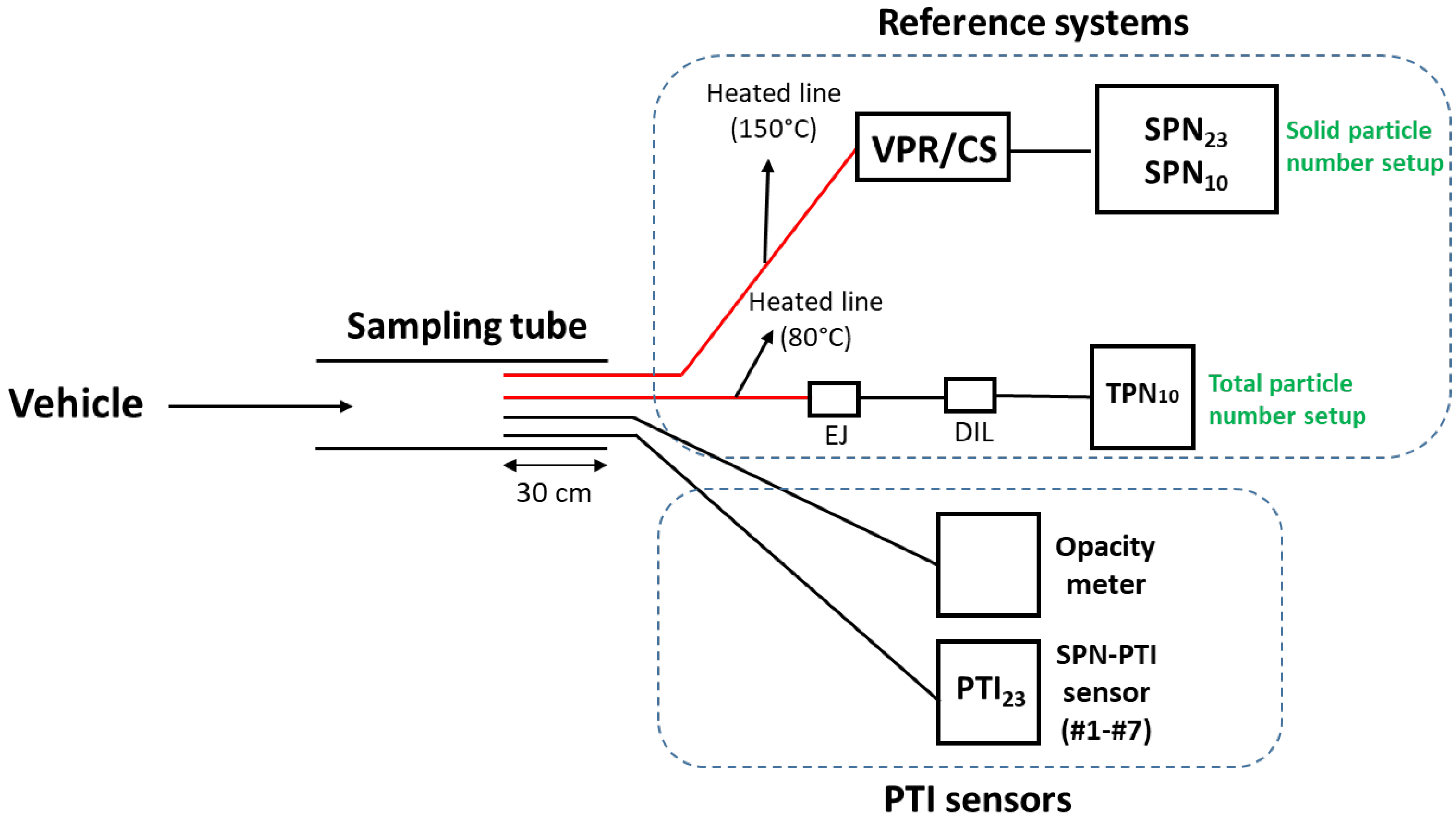
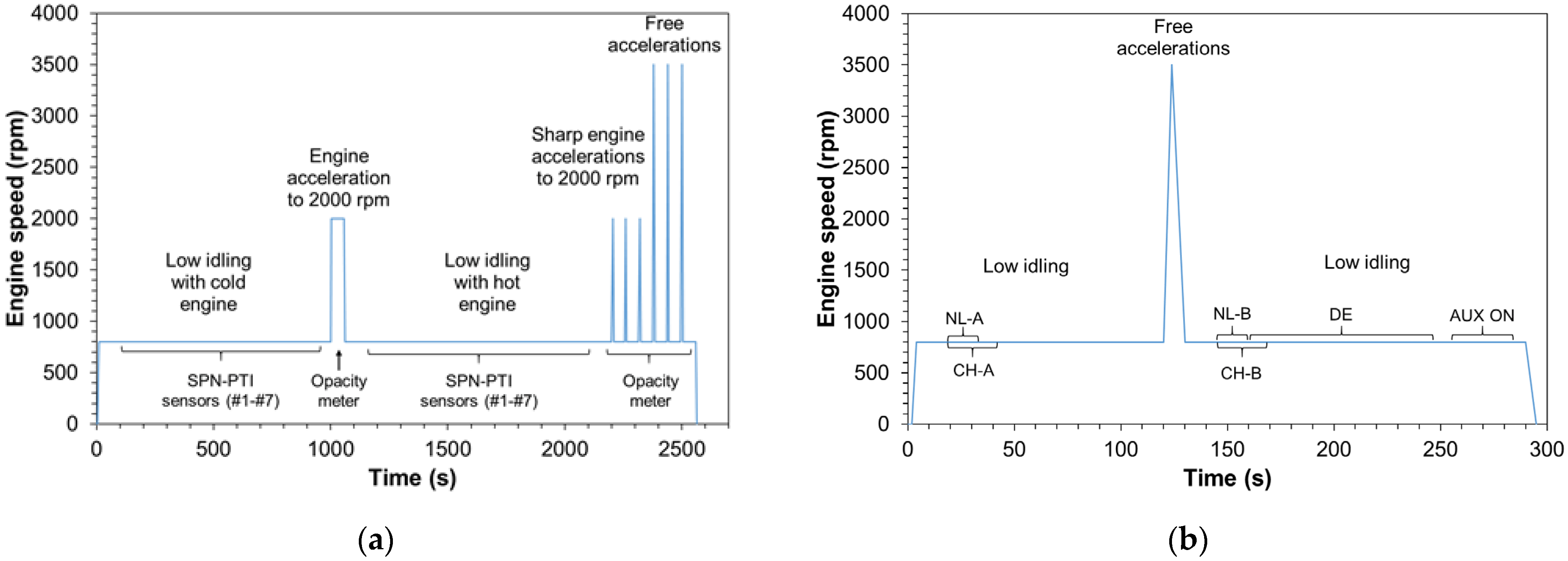
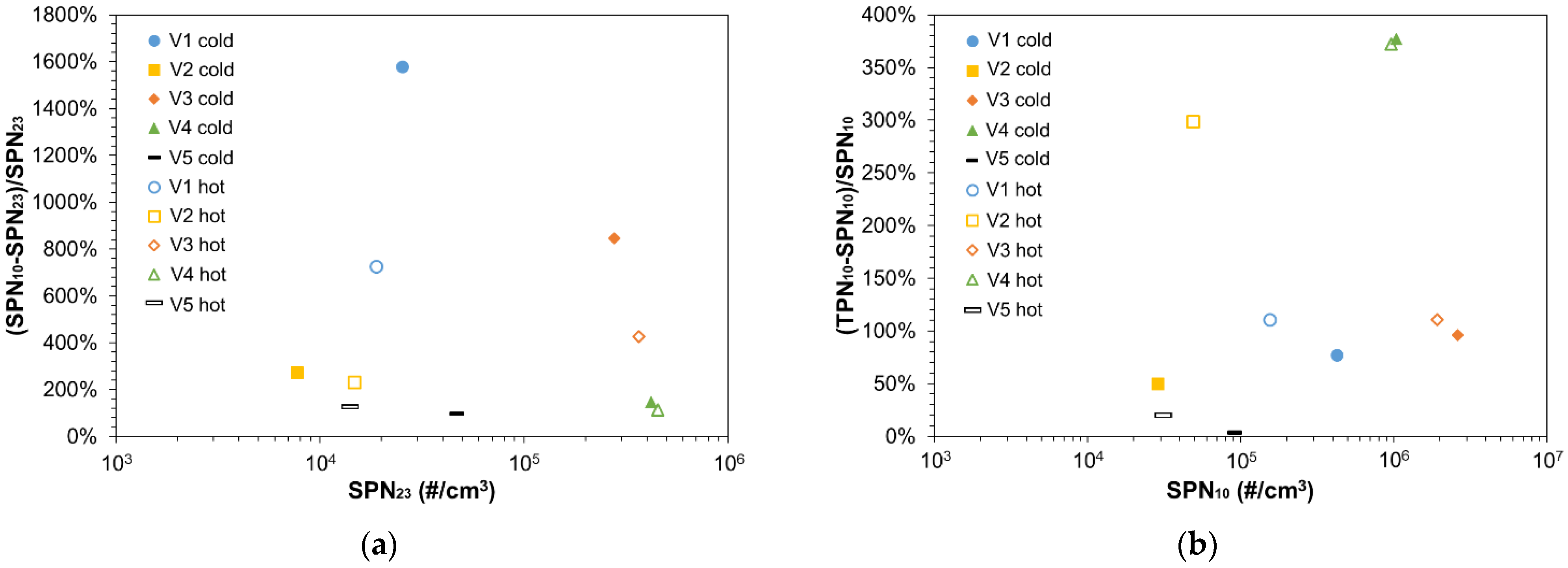
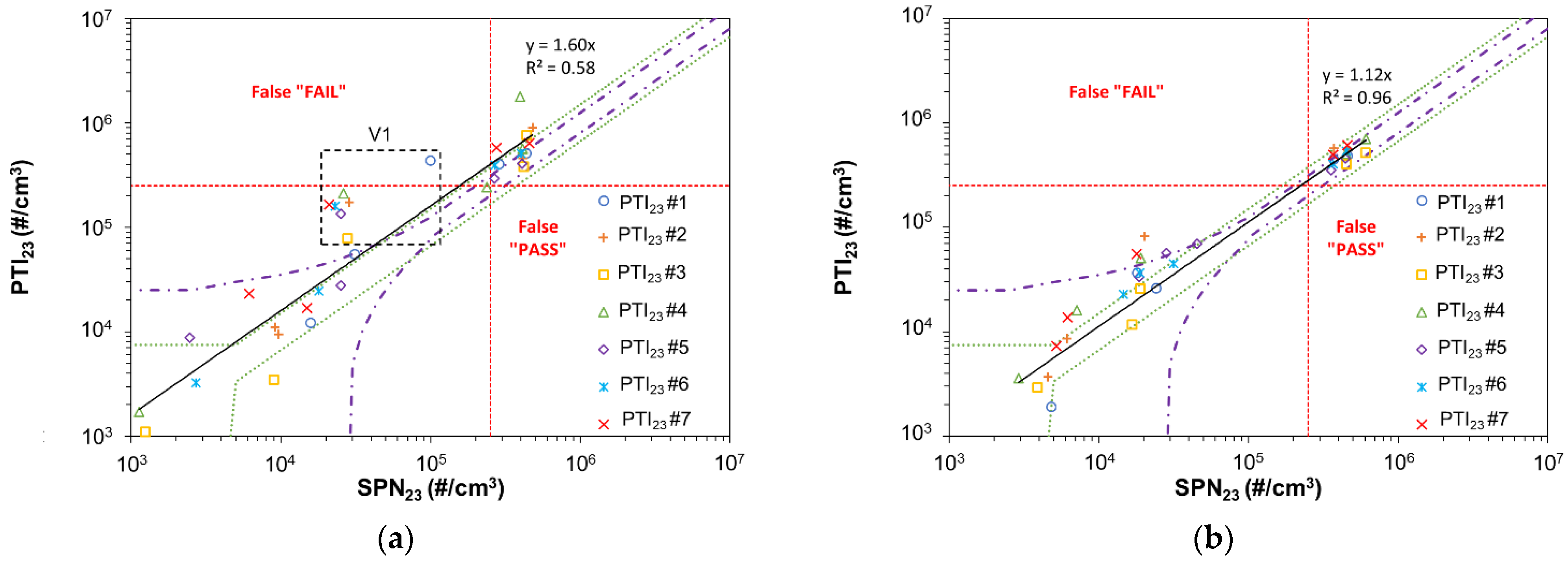
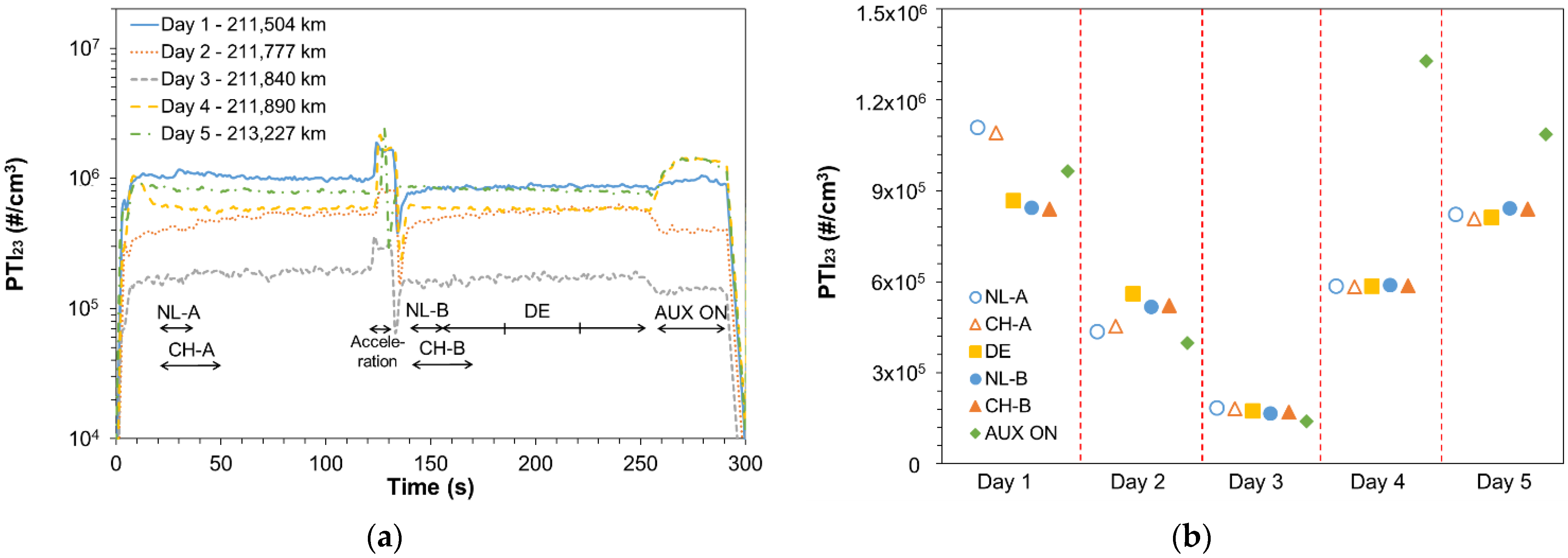
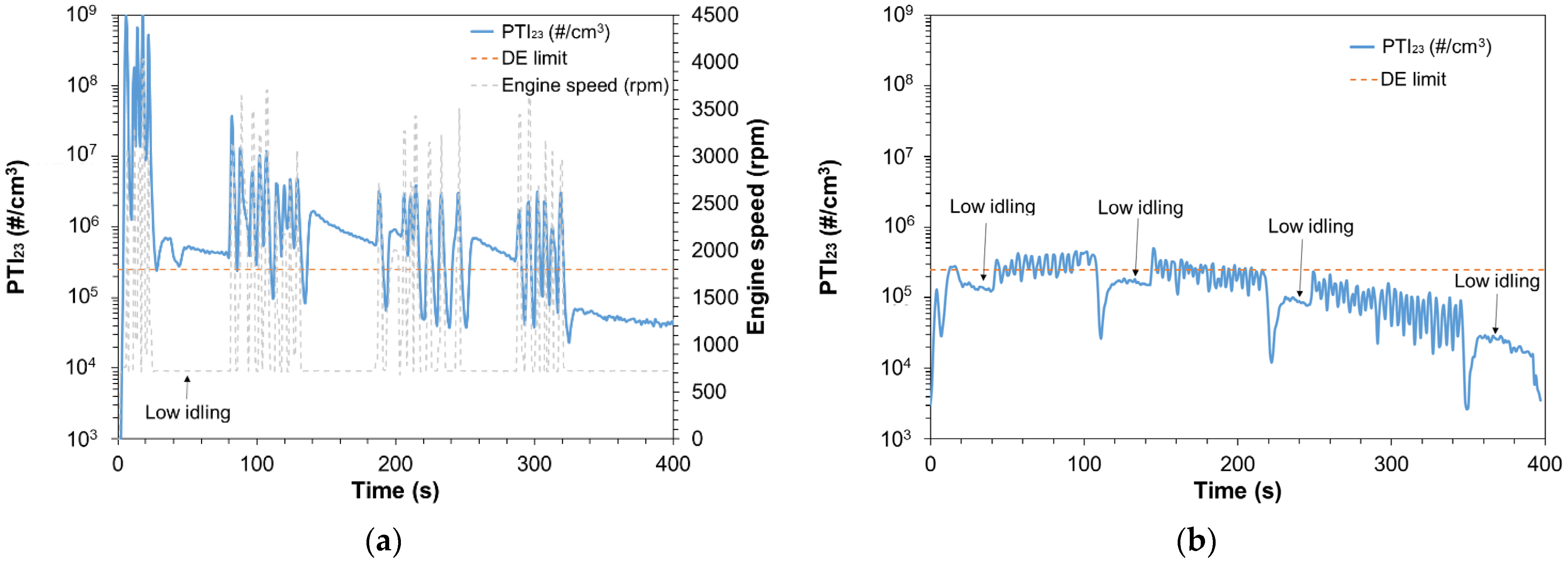

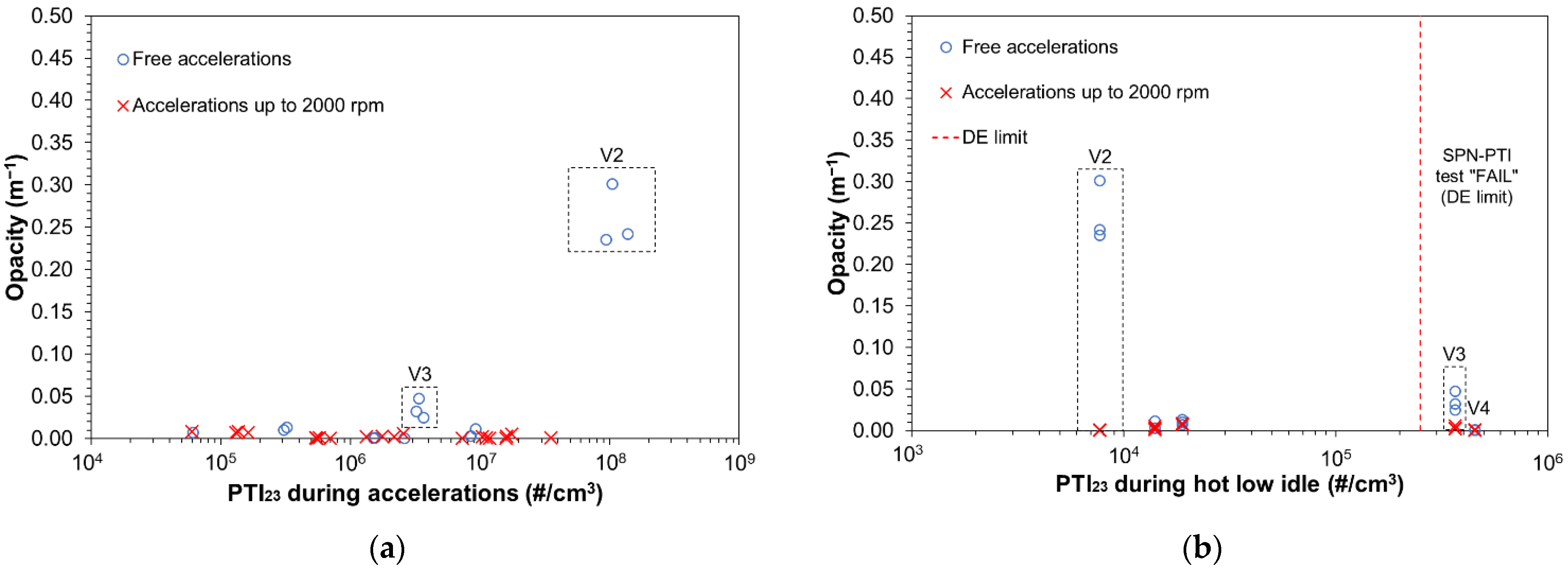
| Country | Engine Conditions | Test Duration (s) | Repetitions | Limit (#/cm3) | Application |
|---|---|---|---|---|---|
| NL/BE | Cold (only in case of ‘pass’ result) or hot | 15 | 1 | 106 | Euro 5 and 6 |
| DE | Hot (Engine coolant >60 °C) | 30 | 3 | 2.5 × 105 | Euro 6 |
| CH | Hot | 5 | 3 | 105 a or 2.5 × 105 b | DPF-equipped |
| Code | Euro | Fuel | Year | Mileage (km) | Engine Displacement (cm3) | Power (kW) | Particulate Filter | Test |
|---|---|---|---|---|---|---|---|---|
| V1 | 6b | Diesel | 2017 | 23,800 | 1560 | 88 | Yes | ACC, TA, OPA |
| V2 | 6b | Gasoline PFI | 2017 | 20,000 | 1400 | 70 | No | ACC, OPA |
| V3 | 4 | Diesel | 2009 | 211,000 | 1997 | 100 | Yes | ACC, PRO, TA, OPA |
| V4 | 6d | Diesel | 2020 | 5000 | 1968 | 110 | bypassed 1 | ACC, OPA |
| V5 | 5b | Gasoline DI | 2012 | 158,800 | 1197 | 77 | No | ACC, OPA |
| V6 2 | 6d | Diesel | 2021 | 26,700 | 2933 | 210 | Yes | REG, TA |
| V7 | 6c | Diesel | 2017 | 125,500 | 1968 | 110 | Yes | REG, TA |
| V8 | 6d-TEMP | Diesel | 2019 | 11,600 | 1997 | 107 | Yes | TA |
| V9 3 | 6d | Diesel | 2020 | 5000 | 1950 | 143 | Yes | TA |
Publisher’s Note: MDPI stays neutral with regard to jurisdictional claims in published maps and institutional affiliations. |
© 2022 by the authors. Licensee MDPI, Basel, Switzerland. This article is an open access article distributed under the terms and conditions of the Creative Commons Attribution (CC BY) license (https://creativecommons.org/licenses/by/4.0/).
Share and Cite
Melas, A.; Selleri, T.; Suarez-Bertoa, R.; Giechaskiel, B. Evaluation of Measurement Procedures for Solid Particle Number (SPN) Measurements during the Periodic Technical Inspection (PTI) of Vehicles. Int. J. Environ. Res. Public Health 2022, 19, 7602. https://doi.org/10.3390/ijerph19137602
Melas A, Selleri T, Suarez-Bertoa R, Giechaskiel B. Evaluation of Measurement Procedures for Solid Particle Number (SPN) Measurements during the Periodic Technical Inspection (PTI) of Vehicles. International Journal of Environmental Research and Public Health. 2022; 19(13):7602. https://doi.org/10.3390/ijerph19137602
Chicago/Turabian StyleMelas, Anastasios, Tommaso Selleri, Ricardo Suarez-Bertoa, and Barouch Giechaskiel. 2022. "Evaluation of Measurement Procedures for Solid Particle Number (SPN) Measurements during the Periodic Technical Inspection (PTI) of Vehicles" International Journal of Environmental Research and Public Health 19, no. 13: 7602. https://doi.org/10.3390/ijerph19137602
APA StyleMelas, A., Selleri, T., Suarez-Bertoa, R., & Giechaskiel, B. (2022). Evaluation of Measurement Procedures for Solid Particle Number (SPN) Measurements during the Periodic Technical Inspection (PTI) of Vehicles. International Journal of Environmental Research and Public Health, 19(13), 7602. https://doi.org/10.3390/ijerph19137602







